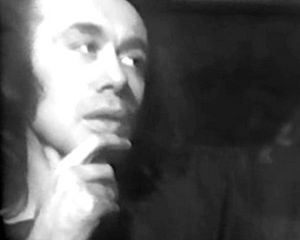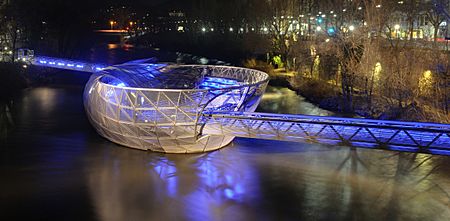Vito Acconci facts for kids
Quick facts for kids
Vito Acconci
|
|
|---|---|

Acconci in 1973
|
|
| Born |
Vito Hannibal Acconci
January 24, 1940 New York City, U.S.
|
| Died | April 27, 2017 (aged 77) New York City, U.S.
|
| Education | College of the Holy Cross University of Iowa |
| Known for | Landscape architect Installation art Performance art Video art |


Vito Acconci (Italian: [ˈviːto akˈkontʃi], /əˈkɒntʃi/; January 24, 1940 – April 27, 2017) was an influential American performance, video and installation artist, whose diverse practice eventually included sculpture, architectural design, and landscape design. His work is considered to have influenced artists including Laurie Anderson, Karen Finley, Bruce Nauman, and Tracey Emin, among others. Acconci was initially interested in radical poetry, but by the late 1960s, he began creating Situationist-influenced performances in the street or for small audiences.
In the late-1970s, he turned to sculpture, architecture and design, greatly increasing the scale of his work, if not his art world profile. Over the next two decades he developed public artworks and parks, airport rest areas, artificial islands and other architectural projects that frequently embraced participation, change and playfulness. Notable works of this period include: Personal Island, designed for Zwolle, the Netherlands (1994); Walkways Through the Wall at the Wisconsin Center, in Milwaukee, WI (1998); and Murinsel, for Graz, Austria (2003). Retrospectives of Acconci's work have been organized by the Stedelijk Museum in Amsterdam (1978) and the Museum of Contemporary Art, Chicago (1980), and his work is in numerous public collections, including those of the Museum of Modern Art and Whitney Museum of American Art. He has been recognized with fellowships from the National Endowment for the Arts (1976, 1980, 1983, 1993), John Simon Guggenheim Memorial Foundation (1979), and American Academy in Rome (1986). In addition to his art and design work, Acconci taught at many higher learning institutions. Acconci died on April 28, 2017, in Manhattan at age 77.
Contents
Life and work
Education
Born Vito Hannibal Acconci in the Bronx, New York in 1940, Acconci attended a Roman Catholic elementary school, high school (Regis High School in New York City), and college. He received a BA in literature from the College of the Holy Cross in 1962 and an MFA in literature and poetry from the University of Iowa. He noted: "There wasn't a woman in my classroom between kindergarten and graduate school." Then he returned to New York City to pursue a career as a poet.
1960s and 70s
Acconci began his career as a poet, editing and self-publishing the poetry magazine 0 TO 9 with Bernadette Mayer in the late 1960s. Produced in quantities of 100 to 350 copies per issue on a mimeograph machine, the magazine mixed contributions by both poets and artists.
In the late 1960s, Acconci transformed himself into a performance and video artist using his own body as a subject for photography, film, video, and performance. Most of his early work incorporated subversive social comment. His performance and video work was marked heavily by confrontation and Situationism. In the mid-1970s, Acconci expanded his métier into the world of audio/visual installations.
1980s
In the 1980s, Acconci turned to permanent sculptures and installations. During this time he invited viewers to create artwork by activating machinery that erected shelters and signs. One of the most prominent examples of these temporary installations is titled Instant House, which was first created in 1980, but was recently exhibited in the summer of 2012 at the Museum of Contemporary Art San Diego. Later, in January 1983, Acconci was a visiting artist at Middlebury College. During that time, he completed Way Station I (Study Chamber), which was his first permanent installation. The sculpture marked a transition for Acconci's career from performance artist to architectural designer. He turned to the creation of furniture and prototypes of houses and gardens in the late 1980s, and in 1988, the artist founded Acconci Studio, which focused on theoretical design and building. Acconci Studio is located on Jay Street in Brooklyn. Acconci designed the United Bamboo store in Tokyo in 2003, and collaborated on concept designs for interactive art vehicle Mister Artsee in 2006, among others including the highly acclaimed: Murinsel in Graz, Austria.
The artist has focused on architecture and landscape design that integrates public and private space.
2000s
One of his later works, Lobby-for-the-Time-Being is an installation in the North Wing Lobby of Bronx Museum of the Arts. It has been there since 2009. The installation fills the lobby with a web of white Corian, creating a long, undulating wall resembling giant paper snowflakes.
In 2010, Acconci completed Waterfall Out & In, a water feature at the visitors' center of the Newtown Creek Wastewater Treatment Plant in Greenpoint, Brooklyn. Part of the piece is indoors and part of the piece is outdoors.
In 2013, Acconci's Way Station I (Study Chamber), a work that was vandalized and destroyed in 1985 after being constructed for Middlebury College, was reinstalled along with an exhibit at the college's museum.
In 2014, Acconci was featured in a video segment, produced by Marc Santo, in which he talks about a few of his favorite projects that were never completed, including a Skate Park in San Jose and a museum of needles in Ichihara, Japan. "I think what unbuildable stuff leads to is maybe a possible reexamination, not so much of the past, but of what's to come," he said in the interview.
Academic career
Acconci taught at many institutions, including the Nova Scotia College of Art and Design, Halifax; San Francisco Art Institute; California Institute of the Arts, Valencia; Cooper Union; School of the Art Institute of Chicago; Yale University; University of Iowa, Pratt Institute; and the Parsons School of Design. Prior to his death, he had most recently taught at Brooklyn College in the Art Department and Performance and Interactive Media Arts programs and was an Adjunct Associate Professor at Pratt Institute in the Graduate Architecture and Urban Design Department.
Personal life and death
Acconci had been married to the artist Rosemary Mayer in the 1960s. Acconci died on April 28, 2017. He was 77. His cause of death has not been released by his estate. He is survived by his wife, Maria Acconci.
See also
 In Spanish: Vito Acconci para niños
In Spanish: Vito Acconci para niños
- Murinsel
- Conceptual art



